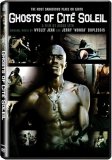| Reviews & Columns |
|
Reviews DVD TV on DVD Blu-ray 4K UHD International DVDs In Theaters Reviews by Studio Video Games Features Collector Series DVDs Easter Egg Database Interviews DVD Talk Radio Feature Articles Columns Anime Talk DVD Savant Horror DVDs The M.O.D. Squad Art House HD Talk Silent DVD
|
DVD Talk Forum |
|
|
| Resources |
|
DVD Price Search Customer Service #'s RCE Info Links |
|
Columns
|
|
|
Ghosts of Cite Soleil
ThinkFilm // Unrated // November 20, 2007
List Price: $27.98 [Buy now and save at Amazon]
Even underneath a place dictated the "most dangerous place on earth" lies a throbbing heart aching to break free. Ghosts of Cite Soleil, a gritty documentary from Asger Leth, gives merit to such a statement. Winding through the dusty streets of this chaotic Haitian town is much like swimming through a sea rife with bloodthirsty sharks; this unnerving yet entrancing documentary makes certain to shed light on the openings that lead towards the few radiant elements of Cite Soleil.
The Film:
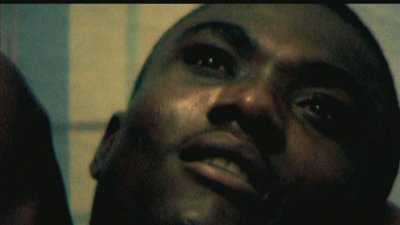
In the ramshackle remnants of Cite Soleil, one of the most dangerous slums in the world positioned in Haiti's Port-au-Prince, the poverty level can be unquestionably heartbreaking. Scavenging for food and money in the dusty dervish becomes a treacherous everyday struggle. Under the control of President Aristide, the area exhibits severe economic and political difficulties that grow worse as an even more potent epidemic plagues the area - the growth of gang warfare. Instead of struggling against the political sanctions, these gangs' leaders instead vow their loyalty to the President as mercenaries.
Life in Cite Soleil is discombobulated from day one. As one of the key characters implies, age expectancy in the area is very low. In that mentality sparks the sprawling desire for younger Haitian adults, and even children, to harness as much brazen activity in their short lives as possible. Seeing younger boys running amuck in the city with guns in arm and gang loyalty in heart becomes an everyday occurrence. Seemingly ordinary kids, like brother Chimere leaders Bily and Haitian 2pac (not to be confused with the deceased American performer), have taken to the streets in angst. As Chimeres, or ghosts as roughly translated, these gangsters bleed through the nights with supposedly government-provided bullets firing in the air.
Ghosts of Cite Soleil, shot in 2004 before and after Aristide's oust, manages to feel almost like a first-person account of this chaos. Leth somehow captured this beautiful footage not as a historical account, but as a very personal portrait. From the starting moments as we focus on Haitian 2pac's summarization of his life into a simple "Maybe good, maybe bad. I don't know", it becomes a heartbreaking, breathtaking exercise in the existence of intimacy in the most dilapidated of situations. As I watched their strife for life in this consumed wedge of the world as it integrates within historical footage of the events, I was terrified. It's hard to imagine what it's like living in a world where life is expected to end quickly and where flourishing chaos seems to be one of the few feasible outlets.

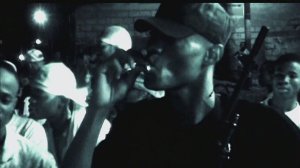
It's within the sole thriving artistic outlet, its beautifully rhythmic music, that Leth's documentary shows the throbbing connection between Cite Soleil and the rest of the world. Spitting out rhythmic flows about the turmoil and political anxiety infuses the film with a striking poetic nature. When the Chimeres aren't fighting, they live and breathe the rhymes of artists like 2pac Shakur and Haitian native Wyclef Jean. At one point during the film, Haitian 2pac actually calls Wyclef Jean and "performs" one of his songs over the phone. Hearing Wyclef's intimate reaction about the country and its beating heart invokes a lot of feeling. When assembling the original tracks for Ghosts of Cite Soleil, he infuses a bit of the work from Haitian 2pac into the mix. As Wyclef mentions, it's obvious that the music strongly influences the cultural fluency in Cite Soleil.
Ghosts of Cite Soleil accomplishes something mesmerizing within its musically remnant and scathing violent nature by permeating its dusty anarchy with radiance. Though we know that these guys fight throughout the streets, we also see their smiling faces as they lovingly carry their children. One of the stronger images of the film contains Bily and his children talking and singing in their home. Interestingly, a French relief worker, Lele, sits and drinks with them in complete peace. When she integrates into the mix amongst the Chimeres, Lele pries honesty and feeling from them while providing as much caring support as she can. However, she treads dangerously close to impassable boundaries of these throbbing Haitian wars, which adds a dash of further intrigue within the grating conflict.
Ultimately, Ghosts of Cite Soleil exists to display that violent transitional mayhem within the slums, and Lest's film drives a shot of adrenaline straight down the spine of this narrative that makes it one of the more terse and gripping documentaries I've seen. It accurately and captivatingly paints the portrait of Cite Soleil's consuming nature while also breaking down the barriers lifted about the psychotic nature of the Haitian gang leaders. Cite Soleil holsters a lot of dark, crumbling layers, but Ghosts of Cite Soleil shows the shining light pouring through the cracks. Lest stretches equally across both evocativeness and aggression here in feverish fashion by crafting an experience not easily forgotten.
The DVD:
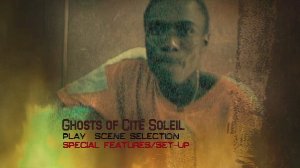
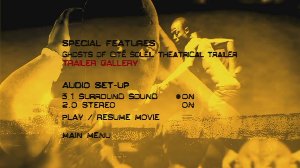
ThinkFilm presents Ghosts of Cite Soleil in a standard keepcase DVD with fitting coverart and discart.
The Video:
Ghosts of Cite Soleil encapsulates its image within a 1.85:1 anamorphic widescreen presentation. The visual style and editing harnesses a very stringent, scathing attitude, making the viewing experience one void of many pleasurable images. As erratic as the beauty is in the film, the same can be said for the clarity with the transfer. Fluctuating between 16mm and video sources, the quality of the print can stretch from strikingly detailed to immensely fuzzy in this DVD presentation. Aliasing can be seen on along just about every single straight line in the film, from the shafts of glasses to the edges of diagonal buildings. I'm chalking up these problematic points to the original material, though. What's important is the fact that the level of detail and color saturation within the shots can be striking for the source.
The Audio:
Though it's presented in Dolby 5.1, Ghosts of Cite Soleil is a very front-heavy film. Activity trickles to the back very sparsely, but mostly the dialogue and music stay to the front. Considering that, the film sounds fantastic for its source. All the music sounds crisp and deep, reaching towards the LFE channel with a lot of brevity. It's a bustling film sporting a lot of activity, and the audio track sounds apt for the job. A Dolby 2.0 track is also available, while subtitles are locked on English.
The Extras:
A Theatrical Trailer and a separate release Trailer Gallery are the sole supplements available, aside from a Chapter Selection.
-----
Final Thoughts:
Ghosts of Cite Soleil documents the Chimere gang wars and Aristide political crumble in Haiti with incredible vigor. It's thoroughly gripping, especially in the final act when utter political chaos ensues. Though the editing style can be a bit hard on the eyes, it's a documentary film fueled to capacity with tension and emotion that well surpasses any harshness on the eyes. Though the content on the disc might only be suitable for a few pass-throughs because of the ruggedness of the material, Ghosts of Cite Soleil's narrative still comes very strongly Recommended.
Thomas Spurlin, Staff Reviewer -- DVDTalk Reviews | Personal Blog/Site
The Film:

In the ramshackle remnants of Cite Soleil, one of the most dangerous slums in the world positioned in Haiti's Port-au-Prince, the poverty level can be unquestionably heartbreaking. Scavenging for food and money in the dusty dervish becomes a treacherous everyday struggle. Under the control of President Aristide, the area exhibits severe economic and political difficulties that grow worse as an even more potent epidemic plagues the area - the growth of gang warfare. Instead of struggling against the political sanctions, these gangs' leaders instead vow their loyalty to the President as mercenaries.
Life in Cite Soleil is discombobulated from day one. As one of the key characters implies, age expectancy in the area is very low. In that mentality sparks the sprawling desire for younger Haitian adults, and even children, to harness as much brazen activity in their short lives as possible. Seeing younger boys running amuck in the city with guns in arm and gang loyalty in heart becomes an everyday occurrence. Seemingly ordinary kids, like brother Chimere leaders Bily and Haitian 2pac (not to be confused with the deceased American performer), have taken to the streets in angst. As Chimeres, or ghosts as roughly translated, these gangsters bleed through the nights with supposedly government-provided bullets firing in the air.
Ghosts of Cite Soleil, shot in 2004 before and after Aristide's oust, manages to feel almost like a first-person account of this chaos. Leth somehow captured this beautiful footage not as a historical account, but as a very personal portrait. From the starting moments as we focus on Haitian 2pac's summarization of his life into a simple "Maybe good, maybe bad. I don't know", it becomes a heartbreaking, breathtaking exercise in the existence of intimacy in the most dilapidated of situations. As I watched their strife for life in this consumed wedge of the world as it integrates within historical footage of the events, I was terrified. It's hard to imagine what it's like living in a world where life is expected to end quickly and where flourishing chaos seems to be one of the few feasible outlets.


It's within the sole thriving artistic outlet, its beautifully rhythmic music, that Leth's documentary shows the throbbing connection between Cite Soleil and the rest of the world. Spitting out rhythmic flows about the turmoil and political anxiety infuses the film with a striking poetic nature. When the Chimeres aren't fighting, they live and breathe the rhymes of artists like 2pac Shakur and Haitian native Wyclef Jean. At one point during the film, Haitian 2pac actually calls Wyclef Jean and "performs" one of his songs over the phone. Hearing Wyclef's intimate reaction about the country and its beating heart invokes a lot of feeling. When assembling the original tracks for Ghosts of Cite Soleil, he infuses a bit of the work from Haitian 2pac into the mix. As Wyclef mentions, it's obvious that the music strongly influences the cultural fluency in Cite Soleil.
Ghosts of Cite Soleil accomplishes something mesmerizing within its musically remnant and scathing violent nature by permeating its dusty anarchy with radiance. Though we know that these guys fight throughout the streets, we also see their smiling faces as they lovingly carry their children. One of the stronger images of the film contains Bily and his children talking and singing in their home. Interestingly, a French relief worker, Lele, sits and drinks with them in complete peace. When she integrates into the mix amongst the Chimeres, Lele pries honesty and feeling from them while providing as much caring support as she can. However, she treads dangerously close to impassable boundaries of these throbbing Haitian wars, which adds a dash of further intrigue within the grating conflict.
Ultimately, Ghosts of Cite Soleil exists to display that violent transitional mayhem within the slums, and Lest's film drives a shot of adrenaline straight down the spine of this narrative that makes it one of the more terse and gripping documentaries I've seen. It accurately and captivatingly paints the portrait of Cite Soleil's consuming nature while also breaking down the barriers lifted about the psychotic nature of the Haitian gang leaders. Cite Soleil holsters a lot of dark, crumbling layers, but Ghosts of Cite Soleil shows the shining light pouring through the cracks. Lest stretches equally across both evocativeness and aggression here in feverish fashion by crafting an experience not easily forgotten.
The DVD:


ThinkFilm presents Ghosts of Cite Soleil in a standard keepcase DVD with fitting coverart and discart.
The Video:
Ghosts of Cite Soleil encapsulates its image within a 1.85:1 anamorphic widescreen presentation. The visual style and editing harnesses a very stringent, scathing attitude, making the viewing experience one void of many pleasurable images. As erratic as the beauty is in the film, the same can be said for the clarity with the transfer. Fluctuating between 16mm and video sources, the quality of the print can stretch from strikingly detailed to immensely fuzzy in this DVD presentation. Aliasing can be seen on along just about every single straight line in the film, from the shafts of glasses to the edges of diagonal buildings. I'm chalking up these problematic points to the original material, though. What's important is the fact that the level of detail and color saturation within the shots can be striking for the source.
The Audio:
Though it's presented in Dolby 5.1, Ghosts of Cite Soleil is a very front-heavy film. Activity trickles to the back very sparsely, but mostly the dialogue and music stay to the front. Considering that, the film sounds fantastic for its source. All the music sounds crisp and deep, reaching towards the LFE channel with a lot of brevity. It's a bustling film sporting a lot of activity, and the audio track sounds apt for the job. A Dolby 2.0 track is also available, while subtitles are locked on English.
The Extras:
A Theatrical Trailer and a separate release Trailer Gallery are the sole supplements available, aside from a Chapter Selection.
-----
Final Thoughts:
Ghosts of Cite Soleil documents the Chimere gang wars and Aristide political crumble in Haiti with incredible vigor. It's thoroughly gripping, especially in the final act when utter political chaos ensues. Though the editing style can be a bit hard on the eyes, it's a documentary film fueled to capacity with tension and emotion that well surpasses any harshness on the eyes. Though the content on the disc might only be suitable for a few pass-throughs because of the ruggedness of the material, Ghosts of Cite Soleil's narrative still comes very strongly Recommended.
|
| Popular Reviews |
| Sponsored Links |
|
|
| Sponsored Links |
|
|
| Release List | Reviews | Shop | Newsletter | Forum | DVD Giveaways | Blu-Ray | Advertise |
|
Copyright 2024 DVDTalk.com All Rights Reserved. Legal Info, Privacy Policy, Terms of Use,
Manage Preferences,
Your Privacy Choices | |||||||









